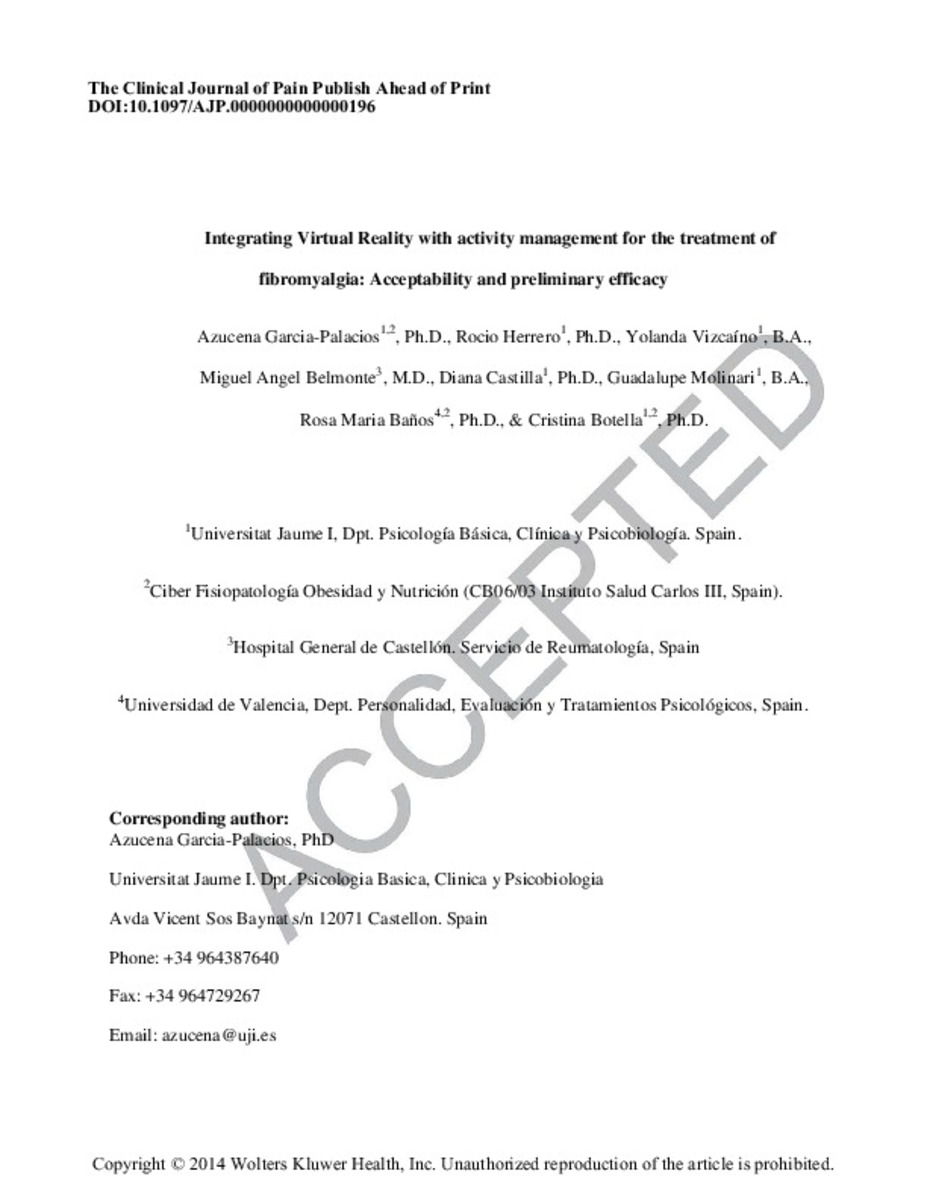Mostrar el registro sencillo del ítem
Integrating Virtual Reality With Activity Management for the Treatment of Fibromyalgia Acceptability and Preliminary Efficacy
| dc.contributor.author | Díaz-García, Amanda | |
| dc.contributor.author | Herrero Camarano, Rocío | |
| dc.contributor.author | Vizcaíno, Yolanda | |
| dc.contributor.author | Belmonte, Miguel Ángel | |
| dc.contributor.author | Castilla, Diana | |
| dc.contributor.author | Molinari, Guadalupe | |
| dc.contributor.author | Baños, Rosa Maria | |
| dc.contributor.author | Botella, Cristina | |
| dc.date.accessioned | 2016-03-15T11:08:34Z | |
| dc.date.available | 2016-03-15T11:08:34Z | |
| dc.date.issued | 2015-06 | |
| dc.identifier.citation | GARCIA-PALACIOS, Azucena, et al. Integrating Virtual Reality With Activity Management for the Treatment of Fibromyalgia: Acceptability and Preliminary Efficacy. The Clinical journal of pain, 2015, vol. 31, no 6, p. 564-572 | ca_CA |
| dc.identifier.issn | 0749-8047 | |
| dc.identifier.uri | http://hdl.handle.net/10234/153845 | |
| dc.description.abstract | Objectives: Cognitive-behavioral therapies (CBT) for fibromyalgia syndrome (FMS) are important interventions in the management of this condition. Empirical evidence reports that although the results are promising, further research is needed to respond more appropriately to these patients. This study focuses on exploring the use of Virtual Reality (VR) as an adjunct to the activity management component. The aim of this study is to present the results of a small-sized randomized controlled trial to test the preliminary efficacy and acceptability of this component. Materials and Methods: The final sample was composed of 61 women diagnosed with FMS according to the American College of Rheumatology. The sample was randomly allocated to 2 conditions: VR treatment and treatment as usual. Results: Participants in the VR condition achieved significant improvements in the primary outcome: disability measured with the FIQ. The improvement was also significant in secondary outcomes, such as perceived quality of life and some of the coping strategies included in the Chronic Pain Coping Inventory: task persistence and exercise. There were no differences in other secondary outcome measures like pain intensity and interference and depression. Participants reported high satisfaction with the VR component. Discussion: The effects were related to the psychological aspects targeted in the treatment. The component was well accepted by FMS patients referred from a public hospital. These findings show that the VR component could be useful in the CBT treatment of FMS and encourage us to continue exploring the use of integrating VR with CBT interventions for the treatment of FMS. | ca_CA |
| dc.description.sponsorShip | The research presented in this paper was funded in part by Fundació La Marató de TV3 (Ajuts de la Marató de TV3 2006), Ministerio de Educación y Ciencia. Spain. PROYECTOS CONSOLIDER-C (SEJ2006-14301/PSIC), Fundació Caixa Castelló-Bancaixa (P11B2009-30), and by Generalitat Valenciana, Redes de Excelencia ISIC (ISIC/2012/012). | ca_CA |
| dc.format.extent | 38 p. | ca_CA |
| dc.format.mimetype | application/pdf | ca_CA |
| dc.language.iso | eng | ca_CA |
| dc.publisher | Wolters Kluwer Health | ca_CA |
| dc.relation.isPartOf | The Clinical journal of pain, 2015, vol. 31, no 6 | ca_CA |
| dc.rights | Copyright © 2015 Wolters Kluwer Health, Inc. All rights reserved. | ca_CA |
| dc.rights.uri | http://rightsstatements.org/vocab/InC/1.0/ | * |
| dc.subject | chronic pain | ca_CA |
| dc.subject | fibromyalgia | ca_CA |
| dc.subject | cognitive-behavioral therapy | ca_CA |
| dc.subject | activity management | ca_CA |
| dc.subject | information and communication technology | ca_CA |
| dc.subject | virtual reality | ca_CA |
| dc.title | Integrating Virtual Reality With Activity Management for the Treatment of Fibromyalgia Acceptability and Preliminary Efficacy | ca_CA |
| dc.type | info:eu-repo/semantics/article | ca_CA |
| dc.identifier.doi | http://dx.doi.org/10.1097/AJP.0000000000000196 | |
| dc.rights.accessRights | info:eu-repo/semantics/openAccess | ca_CA |
| dc.relation.publisherVersion | http://journals.lww.com/clinicalpain/Abstract/2015/06000/Integrating_Virtual_Reality_With_Activity.10.aspx | ca_CA |
| dc.type.version | info:eu-repo/semantics/acceptedVersion | ca_CA |
Ficheros en el ítem
Este ítem aparece en la(s) siguiente(s) colección(ones)
-
PSB_Articles [1293]
Articles de publicacions periòdiques







